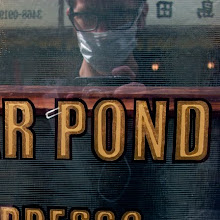I observed a palpable sense of transformation running through many of the booths at VOLTA. This could mean transformation in time, throughout history (specific to art and in general) and in brief durations, transformation from comfort to pain and vice versa, physical and interventional transformation. This idea spanned mediums and artistic intent, so I am interested in investigating this further.
Mathias Kessler, the German artist showing at Galerie Heike Strelow (Booth V9), presents a literal sense of this changing based on the environment. Photography from his expeditions to Ilulissat, Greenland — the epitome of remote in an overpopulated world — and those experiences led to his attempt at capturing that essence and presenting it to us. Installed is a freezing mirror, etched with the world from the POV of the Arctic Circle, and a heat exchanger attuned to the climate of the booth. We sense the cold of this environment whilst contributing to its melting; the more of us viewing it, the faster it melts. It is a visceral interpretation of global warming, the melting at the poles, and a trip to a location that we may never be able to take ourselves. "Nowhere to be Found" is an arresting scene: a human skull suspended in a saltwater tank, bearing growths of sea life. Over several years this will transform into a coral reef. I find this piece incredibly fascinating. There seems to be a dialogue of human activity on deliberate transformation, to the downfall of the environment and to us as a people. However, "Nowhere to be Found", though manufactured by Kessler, is different. This time human intervention (the artist) is supporting life (fragile coral reefs), and by doing so on the surface of a human skull feels somehow terribly appropriate.
Ádám Szabó, of Inda Gallery (Budapest), Booth G9, intervenes in fruit, creating 'perfect' objects. By cutting and sewing — literally — a banana and apple, removing blemishes by grafting a new half or piece, the end results 'should' be glossy and appealing, ready for a food magazine photo shoot and then some high-end supermarket. But these Frankensteinian creations are botched plastic surgery. Szabó shows that an overemphasis on spotless perfection is detrimental and horrific. One wonders too if the produce needed an intervention in the first place, of if it were perfectly nutritious as is.
The economy and transformation figures in both Máximo González's (Galeria Valle Ortí/Valencia/Booth F7) and Thomas Palme's (Teapot/Cologne/Booth G7) works. González uses outdated currency — beginning with that of his native Argentina — in wild works on paper that range from torn and woven abstracts to, lately, more figurative works, of the old money and the faces contained within them interacting with and enacting upon one another. Palme's large graphite works on paper are amalgam figures, men of history (John Berryman, Walt Whitman) with whores' bodies, children with cow-skulls for heads, altogether surrounded by catchphrases from the current economic climate (Caterpillar, Dubai World, Pfizer, Alcoa). The world is a mess.
Todd Pavlisko, showing at the Boston gallery samsøn (Booth E2), delivers a literal sensation of transformation, i.e. incredible pain, via "Centerpiece", where he is filmed hammering a straight-nail through his foot, then pulling his foot up through the nail, over a span of several minutes. It is a wince-inducing cycle of pain, and we hope that is relief he is feeling upon removing himself from the nail, despite the agony of what he just accomplished. His "Still Life" is more complex, combining a self-portrait severed head in marble with Baltic honey amber (the sort that preserves fossils) and tektite meteorites coming out the mouth. The historical references — the prehistoric amber and meteorite, the classical medium of marble — w/ the figuration of his head changes Pavlisko into a point in the timeline of art and the world. The Columbian performance artist Maria José Arjona, represented here by Galerie Anita Beckers (Frankfurt/Booth G3), produced haunting, laborious physical transformations in many of her sustained sculptural pieces. Standing on blocks of ice containing nails for several hours, against the cold and the eventual threat of the sharp objects within creates the secondary transformation, offsetting the pain of the cold with internal body heat, which I am not sure is something that can be willed as much as it is developed over time. The inclusion of transparencies — drawings by Arjona of moments in her performances — allows us to mix and match these scenes, interacting with a performance as we layer one image over another, personalising them. I am excited to see Arjona's contribution to Marina Abramović's upcoming performance at MoMA beginning later this month, as it should produce a special sort of transformation: the cyclical energy from proximity to an audience and, when appropriate, mutual eye contact.
skip to main |
skip to sidebar

